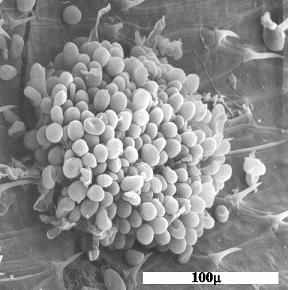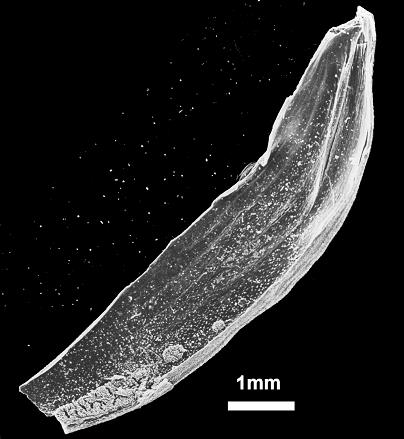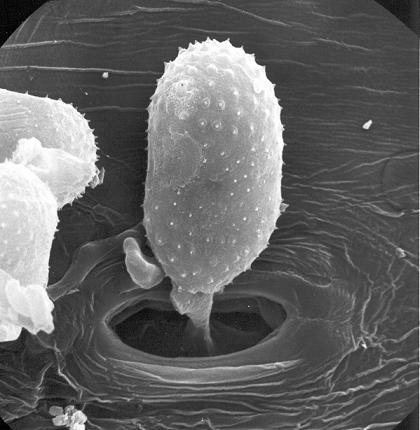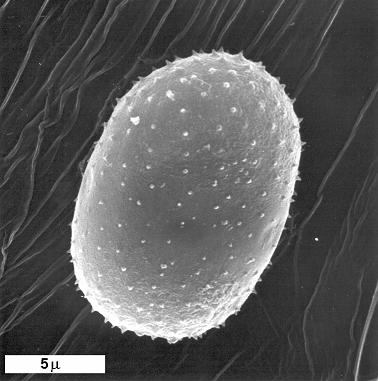The team of the Archaeological Botany Laboratory at the Faculty of Life Sciences at Bar-Ilan University, led by Prof. Mordechai Keslo, reconstructed the nature of grain farming in ancient times with the help of an electron microscope, and reports of epidemics in the Jewish sources

A new discovery by a researcher from Bar-Ilan emerges from an examination of archeological findings and proves that: the rust disease, which spreads in crops, develops at a rapid epidemic rate. The severe and disastrous phenomenon of the rapid spread of the disease can result in crop loss within a season.
The research was presented yesterday, Monday, at the meeting of the Association for the Knowledge of Culture Crops in Israel's Sources, which was held under the auspices of the Faculty of Exact Sciences at Bar-Ilan University.
The team of the Archaeological Botany Laboratory at the Faculty of Life Sciences at Bar-Ilan University, headed by Prof. Mordechai Keslo, reconstructed the nature of grain farming in ancient times by combining a renewed understanding of the Jewish origins with the archaeological findings. A striking example of this is wheat - the most important agricultural plant, which is attacked by rust - one of the most serious diseases of it and of the other grains.

Wheat took its rightful place as the main food of man already at the beginning of human history, and the lives of men depended on its harvest. However, it turns out that weeds, diseases and pests that accompanied the grains throughout history reduced the level of crops. An example of this is the find of the wheat chaldon from the period of the judges, which was discovered in the excavations of Tel Batsh in the lowlands by Prof. Amichai Mazar. This blight that attacked ears found in a jar full of burnt wheat grains, could destroy the crop of an entire country in one growing season and cause it to starve. Although the results of this study were published 26 years ago in the prestigious journal Science, it was only recently that the full picture became clear.
Four photos of charred chaff infected with this disease, taken with a scanning electron microscope by Dr. Yaakov Langazm, make it possible to demonstrate the amazing rate of spread of the disease. The spore of the fungus which is about 15 μm in size (photo 1) germinated on the surface of one of the heads of the wheat, penetrated through the opening of the pinion cold with a diameter of 1-2 μm (photo 2) and created a system of webs that developed into a spore including about 100 spores (photo 3). Some of them penetrated the tissue again and formed clusters of spores on the surface of the chaff (photo 4).

The lifespan of the chaff is about two months and the creation of a new spore takes about two weeks, during this time 3 or 4 generations of spores are created and thus the number of spores multiplies 10,000 times or even 1,000,000 times. The spores may infect other wheat plants and move many kilometers in the wind to other fields and multiply there as well at the same rapid rate. Now it depends on the ability of the lesion to spread quickly in the wheat fields and the resistance of the plant itself.
By the way, the name Hildon was recently given to it because of the brownish-orange color of the spores, which is similar to the color of rust, this color was included in the ancient times within the domain of the color green, hence the name of the disease in the Bible and in the sources of Sage Chazal Yarakon: Hunger because there will be a thing in the land because there will be a locust Hasil because it will be because he has created an enemy for him in the land of his gates, every touch and every disease (XNUMX Kings XNUMX:XNUMX). These are warned everywhere on the Shadfon and the Yarkon […] because it strikes from a walk (Mishna, Ta'anit XNUMX:XNUMX).

The difficult and disastrous phenomenon of the rapid spread of this disease was known in Israel even in ancient times, and in order to prevent it, special prayers were offered in the Temple, and in other parts of the country they even fasted and blew the shofar to wake up the people.
Today, rust-resistant varieties are being developed, but the concern for crops still exists.

One response
Organic material (even if burned) remains for so many years and leaves a signature of fungi that were originally on it? Where are the laws of thermodynamics when you need them? What is the chance that after the fire the fungus settled there? Admittedly, it is strange because she sat down precisely where she sits while the plant is alive (if indeed this is the case, if indeed in the living state she sits on the piony and if indeed no more signs of fungus were found on all the rest of the material).
Prof. Kislo guided me on a nature trip in one of the tours of the first degree as part of a course and I remember him as a witty person who knows the plant community and makes sure to link current science to traditional writings.
Greetings friends,
Ami Bachar